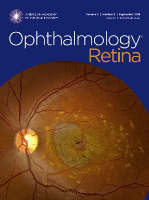
Ophthalmology Retina
Scope & Guideline
Advancing retinal research for a brighter future.
Introduction
Aims and Scopes
- Retinal Disease Mechanisms and Pathophysiology:
Research focusing on the underlying mechanisms of various retinal diseases, including age-related macular degeneration, diabetic retinopathy, and inherited retinal diseases. Studies often involve genetic, biochemical, and imaging analyses. - Innovative Diagnostic Techniques:
The journal includes studies on advancements in diagnostic imaging technologies such as OCT (Optical Coherence Tomography), OCT angiography, and ultrawide-field imaging, which enhance the ability to diagnose and monitor retinal diseases. - Therapeutic Interventions and Clinical Trials:
A strong emphasis on clinical trials evaluating new treatments, including anti-VEGF therapies, corticosteroids, and novel drug delivery systems, providing insights into efficacy, safety, and long-term outcomes. - Surgical Techniques and Outcomes:
Papers detailing surgical interventions for retinal conditions, such as vitrectomy and scleral buckling, along with their outcomes, complications, and best practices. - Patient Outcomes and Quality of Life:
Research assessing the impact of retinal diseases and their treatments on patients' visual function and overall quality of life, often utilizing patient-reported outcomes.
Trending and Emerging
- Artificial Intelligence and Machine Learning:
There is a notable increase in studies utilizing AI and machine learning for diagnostic purposes, treatment prediction, and enhancing imaging analysis, showcasing the integration of technology in ophthalmology. - Personalized Medicine Approaches:
Emerging focus on personalized treatment strategies tailored to individual patient characteristics, particularly in managing age-related macular degeneration and diabetic retinopathy. - Long-term Outcomes and Real-world Data:
An increase in research analyzing long-term patient outcomes and real-world evidence from large databases, providing insights into the effectiveness and safety of treatments in everyday clinical settings. - Multimodal Imaging Techniques:
Growing interest in combining various imaging techniques (e.g., OCT, fundus photography, and fluorescein angiography) to provide comprehensive assessments of retinal diseases. - Genetic and Molecular Research:
Emerging studies exploring the genetic underpinnings of retinal diseases, contributing to better understanding, diagnosis, and potential gene therapies.
Declining or Waning
- Traditional Imaging Techniques:
There is a noticeable decrease in papers focusing on older imaging modalities, as advancements in OCT and other novel imaging techniques gain prominence. - Basic Science Research:
A waning interest in basic science studies that do not directly translate into clinical applications, with a shift towards translational research that connects laboratory findings to patient care. - General Ophthalmology Topics:
Less emphasis on broader ophthalmology topics not specifically related to retinal diseases, as the journal narrows its focus to more specialized areas within retina. - Outdated Therapeutic Approaches:
Fewer studies on older treatment modalities that have been largely replaced by newer, more effective therapies, such as the decline in research on laser treatments for conditions like diabetic retinopathy.
Similar Journals

RETINA-THE JOURNAL OF RETINAL AND VITREOUS DISEASES
Transforming Retinal Research into Clinical PracticeRETINA - THE JOURNAL OF RETINAL AND VITREOUS DISEASES is a premier peer-reviewed journal dedicated to advancing the knowledge and practice of retinal and vitreous disorders. Published by LIPPINCOTT WILLIAMS & WILKINS, this esteemed journal boasts a significant impact factor, affirming its standing in the academic community. With a long history of publication since 1981, its scope covers cutting-edge research and innovations aimed at improving patient outcomes in ophthalmology. As evidenced by its recent categorization in the Q1 quartile for both Medicine (miscellaneous) and Ophthalmology in 2023, the journal ranks impressively, placing it in the 84th percentile among its peers. Researchers, clinicians, and students will find valuable insights and evidence-based articles that contribute to the ever-evolving landscape of retinal health. RETINA remains committed to fostering an environment for scholarly dialogue and dissemination of knowledge, ensuring its readers are at the forefront of advancements in their field.

Ophthalmic Surgery Lasers & Imaging Retina
Fostering Collaboration in the World of OphthalmologyOphthalmic Surgery Lasers & Imaging Retina is a distinguished journal dedicated to the dissemination of cutting-edge research and clinical advancements in the fields of ophthalmology, surgery, and the application of lasers in retinal care. Published by SLACK INC since its inception in 2013, this journal operates without an open access model, catering primarily to a scholarly audience seeking in-depth and impactful studies. With an impressive impact factor and categorized within the Q2 quartile in respective fields for 2023, it features contributions that significantly enhance the understanding and treatment of ocular diseases. The journal's robust editorial board ensures that only rigorous and innovative research is presented, making it a vital resource for researchers, healthcare professionals, and students who aim to stay at the forefront of ophthalmic surgery and imaging techniques. It continues to forge a path for collaboration and knowledge sharing within the global ophthalmology community.

Translational Vision Science & Technology
Advancing the Frontiers of Vision Science and TechnologyTranslational Vision Science & Technology is a premier open access journal dedicated to the advancement of the field of ophthalmology and biomedical engineering. Published by the Association for Research in Vision and Ophthalmology, Inc., this journal has established itself as a leading source of high-quality research since its inception in 2013, achieving a remarkable impact factor reflective of its influential contribution to the field. With an impressive ranking of #21 in Ophthalmology and #120 in Biomedical Engineering within the Scopus database, it sits within the prestigious Q1 quartile for both categories as of 2023, further validating its significance. The journal's scope encompasses a wide variety of topics focused on the intersection of ophthalmological science and technological innovation, welcoming contributions that promote the understanding and treatment of visual disorders. Available as an Open Access publication since 2016, it ensures that cutting-edge research is freely accessible to researchers, practitioners, and students worldwide, facilitating the rapid dissemination of knowledge essential for the advancement of vision science.

Journal of Ophthalmology
Illuminating Innovations in OphthalmologyThe Journal of Ophthalmology, published by HINDAWI LTD, is an esteemed open-access journal that has been disseminating significant research in the field of ophthalmology since 2009. With an ISSN of 2090-004X and an E-ISSN of 2090-0058, this journal facilitates global access to cutting-edge studies, making it an essential resource for researchers, clinicians, and students alike. Ranked in the Q2 category of ophthalmology for 2023, the journal holds a commendable position with a Scopus rank of #37 out of 137 in its field, placing it in the 73rd percentile. The journal encompasses a variety of topics such as clinical advancements, surgical techniques, and innovative technologies in eye care, aiming to advance scientific knowledge and clinical practice in ophthalmology. By providing a platform for both novel research and comprehensive reviews, the Journal of Ophthalmology is instrumental in fostering collaboration and scholarly communication within the global eye health community, and its commitment to open access ensures that impactful research reaches a wide audience without barriers.
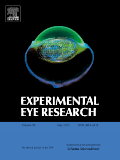
EXPERIMENTAL EYE RESEARCH
Pioneering Insights into Eye Function and DisordersEXPERIMENTAL EYE RESEARCH, published by Academic Press Ltd - Elsevier Science Ltd, is a preeminent journal dedicated to advancing the fields of ophthalmology and neuroscience. With a history of insightful publications dating back to 1961, this journal serves as a critical platform for researchers, professionals, and students interested in the cellular and molecular mechanisms underlying visual processes. The journal boasts impressive rankings, including being placed in the top quartile (Q1) of both the Ophthalmology and Sensory Systems categories, and is recognized in the 2nd quartile (Q2) for Cellular and Molecular Neuroscience. With an impact factor reflecting its significant contribution to the field, EXPERIMENTAL EYE RESEARCH is a valuable resource that promotes the exchange of innovative research and ideas essential for understanding the complexities of eye function and vision-related disorders. Researchers looking to publish their findings or stay abreast of the latest studies will find this journal a vital component of their academic toolkit.
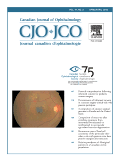
CANADIAN JOURNAL OF OPHTHALMOLOGY-JOURNAL CANADIEN D OPHTALMOLOGIE
Illuminating the future of vision care.Canadian Journal of Ophthalmology - Journal Canadien d'Ophtalmologie, published by the prestigious Canadian Ophthalmological Society, serves as a leading platform for disseminating cutting-edge research in the field of ophthalmology. With an ISSN of 0008-4182 and E-ISSN 1715-3360, the journal boasts a commendable impact factor and maintains a strong presence within the medicine and ophthalmology categories, ranking in the Q2 quartile. This journal not only provides significant insights into clinical practices and advancements but also contributes to the understanding of ocular health issues facing contemporary society. Since its inception in 1966, it has published high-quality research, making substantial strides in both practical and theoretical aspects of ophthalmology until 2024. Although it is not an open-access journal, it establishes a vital resource for researchers, professionals, and students alike, fostering an informed community dedicated to improving vision care.
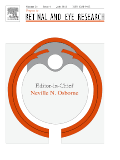
PROGRESS IN RETINAL AND EYE RESEARCH
Advancing the Frontiers of Vision SciencePROGRESS IN RETINAL AND EYE RESEARCH, published by PERGAMON-ELSEVIER SCIENCE LTD, is a premier journal dedicated to the advancement of knowledge in the fields of ophthalmology and sensory systems. With an impressive impact factor and a Q1 category ranking in both Ophthalmology and Sensory Systems as of 2023, this journal exemplifies excellence in research dissemination. Given its stature, it ranks #1 out of 137 in Ophthalmology and #1 out of 42 in Neuroscience - Sensory Systems, placing it within the top percentile of scientific publications in these domains. The journal has been actively contributing to the field since its inception in 1994 and continues to be a vital resource for researchers, clinicians, and students seeking the latest insights and breakthroughs in the understanding of retinal diseases and eye health. While it maintains a traditional subscription model, the journal remains committed to publishing high-quality, peer-reviewed articles that drive forward the frontiers of eye research and therapeutic innovation. With its strong scientific rigor and a vast array of articles, PROGRESS IN RETINAL AND EYE RESEARCH is indispensable for anyone invested in the study of visual sciences.
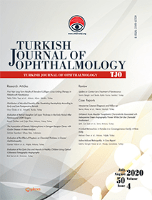
Turk Oftalmoloji Dergisi-Turkish Journal of Ophthalmology
Empowering Ophthalmologists with Cutting-Edge InsightsTurk Oftalmoloji Dergisi - Turkish Journal of Ophthalmology is a premier peer-reviewed publication dedicated to the field of ophthalmology, published by GALENOS PUBL HOUSE. Since its inception in 1997, this Open Access journal has championed the dissemination of high-quality research, fostering an inclusive environment for sharing knowledge and advancements in eye health. With an ISSN of 1300-0659 and an E-ISSN of 2147-2661, the journal serves as a vital resource for researchers, clinicians, and students interested in the latest findings and innovations in ophthalmic sciences. Although its coverage in Scopus has been discontinued since 2017, the journal has garnered a significant rank of 80 out of 114 in the field of Medicine – Ophthalmology, highlighting its relevance and impact within the discipline. Operating out of Istanbul, Turkey, the Turkish Journal of Ophthalmology continues to be a crucial platform for ophthalmologists and researchers to publish their work and advance the understanding of ocular health.
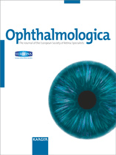
OPHTHALMOLOGICA
Transforming Knowledge into Visionary PracticesOPHTHALMOLOGICA is a prestigious journal published by KARGER, dedicated to the dynamic field of ophthalmology and its interdisciplinary connections with medicine and sensory systems. With a rich history spanning over a century since its inception in 1899, this journal is esteemed for its high-quality research and impactful contributions, maintaining an impressive Q1 quartile ranking in both ophthalmology and miscellaneous medicine as of 2023, alongside a notable Q2 status in sensory systems. The journal's influence is reinforced by its Scopus rankings, where it ranks 26th out of 137 in ophthalmology, showcasing a strong percentile position of 81. Based in Basel, Switzerland, OPHTHALMOLOGICA serves as an essential platform for researchers, professionals, and students, providing essential insights, reviews, and studies that push the boundaries of knowledge in the vision sciences. Although it does not currently offer open access, its contributions are critical for those pursuing advancements in ocular health and related disciplines.
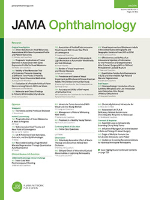
JAMA Ophthalmology
Unlocking the Future of Eye CareJAMA Ophthalmology, the premier journal in the field of ophthalmology, is published by the esteemed American Medical Association. Renowned for its rigorous peer-review process and commitment to advancing eye health research, JAMA Ophthalmology holds a prestigious position in the scientific community, boasting an impressive impact factor and ranking as Q1 in the category of Ophthalmology. With a Scopus rank of #3 out of 137 in its field and a remarkable 98th percentile, the journal serves as an invaluable resource for researchers, healthcare professionals, and students dedicated to the ophthalmic sciences. Readers can explore a wealth of cutting-edge findings, clinical studies, and review articles that not only contribute to the sustainable advancement of ophthalmic knowledge but also foster innovative approaches in patient care. As we converge into 2024, the journal continues to embrace open access principles, ensuring that groundbreaking research is readily available to a global audience, enhancing collaborative efforts and furthering the development of the ophthalmology discipline.